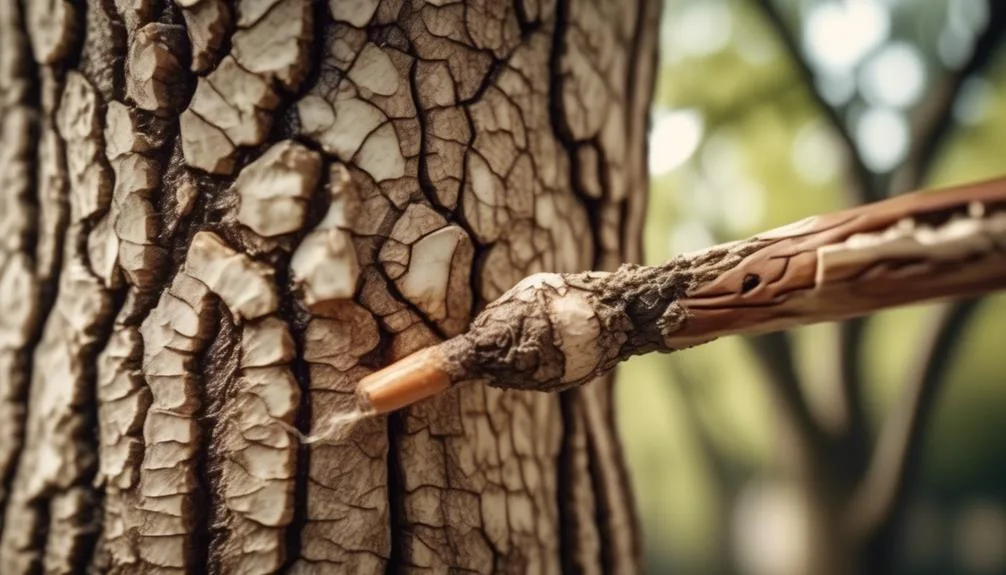Curious about grafting sycamore trees?
While sycamores are renowned for their grand appearance and distinct bark, the possibility of grafting them raises interesting questions.
Exploring the practicality, methods, and success rates of sycamore tree grafting could transform your perception of these iconic trees.
Grafting Sycamore Trees: Feasibility
Grafting sycamore trees can be a viable method for enhancing tree health and productivity. When considering the feasibility of grafting sycamore trees, it's crucial to understand tree species compatibility. Ensure that the sycamore tree species you intend to graft are compatible with the rootstock for successful grafting.
Additionally, having the right grafting tools and equipment is essential. Quality tools such as a sharp grafting knife, grafting tape, and sealing compound are necessary for a successful graft. These tools aid in creating clean cuts, securing the graft union, and protecting the graft site.
Factors Affecting Sycamore Tree Grafting
Understanding the environmental conditions and timing for grafting sycamore trees is crucial for successful outcomes. When considering factors affecting sycamore tree grafting, keep these key points in mind:
- Grafting Compatibility: Ensure that the scion and rootstock are compatible to promote successful union and growth.
- Environmental Conditions: Opt for grafting during early spring when temperatures are mild, and sap flow is active, promoting better healing and growth.
- Rootstock Selection: Choose rootstocks that are healthy, disease-resistant, and well-suited to the local soil and climate conditions.
- Pruning Techniques: Properly prune both the scion and rootstock to encourage successful graft union and reduce competition for resources.
Steps for Grafting Sycamore Trees
When preparing to graft sycamore trees, it's essential to gather all necessary tools and materials before beginning the process.
First, select a healthy, young sycamore tree to serve as the rootstock. Look for a straight, vigorous shoot to ensure a successful graft.
Then, choose a scion from a desirable sycamore variety, making sure it's free from diseases. The scion should be a young, pencil-sized shoot with multiple buds.
Prepare the rootstock and scion by making a sloping cut to increase the contact area for grafting.
Secure the graft with a rubber band or grafting tape, ensuring it's firm but not too tight.
Finally, monitor the graft closely and provide appropriate care to support successful integration.
Following these steps will help you master the grafting process and achieve successful rootstock selection.
Sycamore Tree Grafting Techniques
Considering the various sycamore tree grafting techniques available can help you achieve successful results in cultivating your desired variety. When looking to graft sycamore trees, it's essential to familiarize yourself with the different budding techniques and tree care methods to ensure the best outcomes.
Here are some key grafting techniques to consider:
- T-budding: This method involves making a T-shaped incision in the rootstock and inserting a bud from the desired variety.
- Whip and tongue grafting: This technique involves joining a scion and rootstock by making matching diagonal cuts and securing them together.
- Cleft grafting: By making a vertical cut in the rootstock, a scion is inserted, promoting successful fusion.
- Bark grafting: This technique involves inserting a scion under the bark of the rootstock, allowing for efficient nutrient flow.
Success Rate of Sycamore Tree Grafting
To achieve a successful grafting of sycamore trees, it's essential to understand the factors that influence the success rate of the grafting process. Grafting challenges such as compatibility between the scion and rootstock, proper technique, and environmental conditions can significantly impact the success rate.
Sycamore trees can be challenging to graft due to their susceptibility to diseases and slow healing of wounds. Additionally, grafting alternatives like budding and T-budding can be considered to improve the success rate, especially in cases where traditional grafting methods have lower efficacy.
Understanding these challenges and exploring alternative grafting techniques can increase the likelihood of successful sycamore tree grafting. By addressing these factors, you can enhance the success rate of grafting sycamore trees and achieve healthier, more resilient trees.
Conclusion
In exploring the grafting of sycamore trees, we uncover a potential for creating new varieties with the right techniques and patience.
This process offers a doorway to the expansion of sycamore diversity, highlighting the beauty of nature's adaptability.

My interest in trees started when I first saw the giant sequoias in Yosemite.
I was a teenager then, and I remember thinking, “I need to learn more about this.”
That moment stuck with me.
A few years later, I went on to study forestry at Michigan Tech.
Since graduating, I’ve worked in a mix of hands-on tree care and community education.
I’ve spent over ten years helping people understand how to plant, maintain, and protect the trees in their neighborhoods.
I don’t see trees as just part of the landscape.
They are living things that make a real difference in our daily lives.
